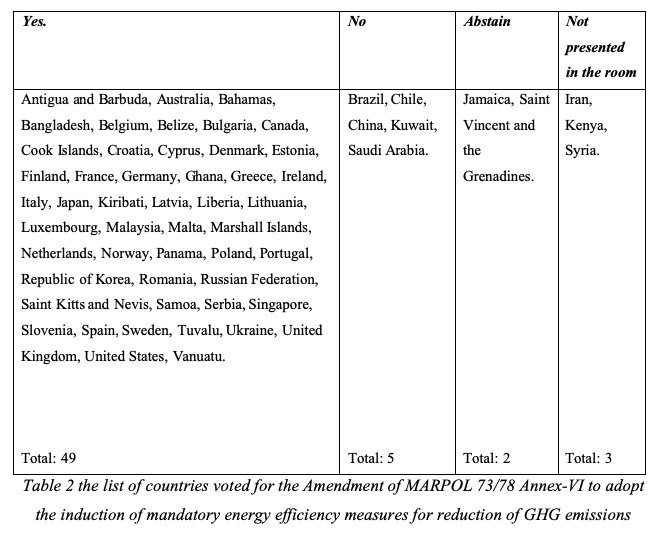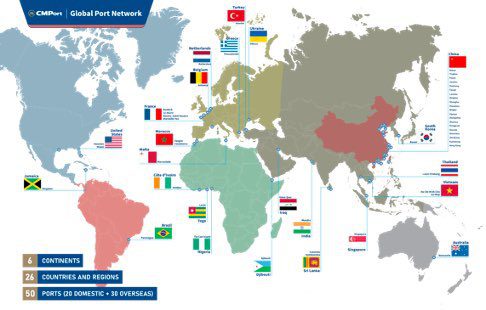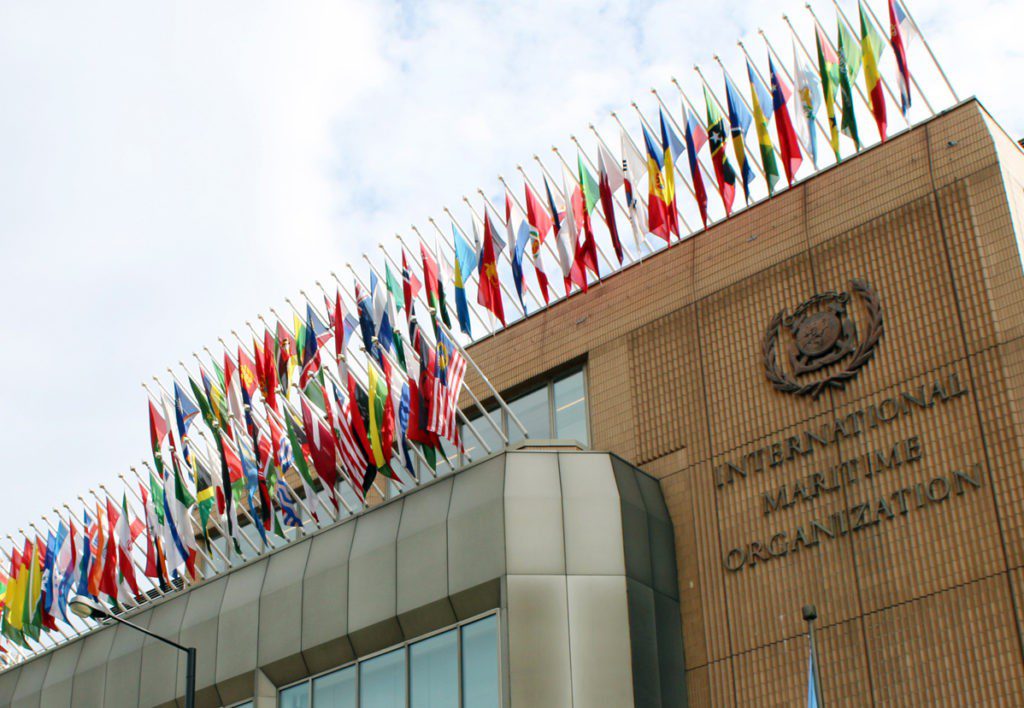The Upcoming 78th Session Marine Environment Protection Committee (MEPC)meeting at the International Maritime Organization (IMO) is scheduled to be held on this monthfrom 06 – 10 June which will be an important meeting on agreeing on mid-term measures”
The climate crisis is considered the biggest challenge faced by humans collectively andClimate Change is directly linked to industrialization and emission of Green House Gases (GHG), decarbonizing such a vast global network of GHG emissions will affect the global economy, especially for developing, least developed, and small island developing states.Moreover, around 60% of GHGs in the current atmosphere were emitted during the industrial era from the 1700s to the late 1900s which is directly linked to developing industries and infrastructure in the Global North. However, during this century most of the Global South nations are unable to meet their national development targets due to the effects of Climate Change, based on this, a narrative as ‘Historical Responsibilities’ or ‘Historical Emissions’ was accepted among the member parties to the UNFCCC. This resulted in a top-down reduction under the Kyoto Protocol and the dividing of the UNFCCC member parties under Annex I, II, and Non-Annex nations.TheInternational Maritime Organization (IMO) was given the mandate from the Kyoto Protocol to address the issue of reducing GHG in the maritime sector, and the current Paris Agreement calls upon all member parties to take action to meet the 1.5 target. The shipping industry which moves around 90% of traded goods is directly linked to the livelihoods of millions of people globally. Given its intercontinental engagement, decarbonization of the shipping industry is considered one of the most difficult sectors to regulate. for example; a ship carrying bulk from Italy could be registered in Panama, yet the shipowners could be from Japan and the management from Korea, Moreover, the ship captain and the craw could be Greek or Russian, in a vessel which was built in South Korea sailing in international and territorial waters.
The shipping industry which emits around 3% GHGs from the global GHG emissions budget was making its way to regulate its GHG footprint since Kyoto Protocol under the IMO.The IMO membership countries add on more different interest groups as flag states, developing countries, least developed countries (LDCs), countries having bunker centered businesses, shipbuilding nations, bunker oil-exporting countries, climate change victim countries, small island developing states (SIDS), countries based on their import and export capacity. In order to have an all-inclusive council the IMO categorize member parties into three main groups in its council, Category (a) 10 States with the largest interest in providing shipping services, Category (b) 10 States with the largest interest in international seaborne trade and Category (c) 20 States not elected under (a) or (b) above, which have special interests in maritime transport or navigation and whose election to the Council will ensure the representation of all major geographic areas of the world.
In the last few years IMO managed to pass ground-breaking regulations by amending the MARPOL Annex IV and adopting the IMO’s GHG strategy. Under this framework IMO manage to identify three main approaches to regulate shipping under technical, operational, and market-based mechanisms.The main outcome of Technical mechanism wasimplementation of the Energy-efficient design index (EEDI)and the operational measures was regulated under theShip Energy Efficient Management Plan (SEEMP)which regulated the current shipping fleet to operate in the most efficient manner.
Moreover, the 2ndIMO GHG study identified that EEDI and SEEMP alone are not able to meet the reduction targets, and proposed to implement a Market-Based Measure (MBM) long with EEDI and SEEMP. Since EEDI and SEEMP will make the current fleet and new building vessels operate at their highest efficiency, MBM’s would make the vessels which are not complying with EEDI and SEEMP more expansive to operate. As a result, shipowners, and investors will be less reluctant to comply.Although MARPOL Annex IV amendments were adopted, developing economies strongly opposed any GHG regulation without first addressing the CBDR principle and proper agreement in Capacity Building and Technology Transfer among member states at IMO.
Disagreements Among Member Nations At IMO
To implement a top-down GHG reduction, IMO member states arenot necessarily divided into developed and developing nations asKyoto protocolsAnnex 1 and Non-Annex countries, Moreover, in post-Paris Agreement further influences states in a bottom-up manner to act upon the global commitment toward an internationally agreed ‘Common Responsibly’ to meet Paris targets. The task is to creatively craft such regulation implementation within the shipping industry while limiting the fluctuation of trade rates resulting possible increase in shipping costs.However, these different categories of countries take different interests when negotiating at MEPC. Table 2, highlights the voting results to adopt the amendments to Annex VI in the MARPOL 73/78. Countries that are listed as Non-Annexed countries inKyoto Protocolsuch as Malaysia, Bangladesh, Republic of Korea voted in favor of the MARPOL 73/78 Annex VI together with other Annex I countries such as the United Kingdom, Norway, France, etc. While Brazil, Chile, China, Kuwait Saudi Arabia voted against the new amendments.This mixture of states’ interests points out the complexity of further amendments to EEDI and the SEEMP developments under the MARPOL 73/78 Annex VI.

However, looking at the past voting patterns, the division among IMO member states clearly highlights two main categories, one which is supporting the CBDR approach to policy implementation other on the NMFT method.Since the beginning of the climate change regime developing states were demanding to continue their national development programs and not slow down due to climate change, and also many developing nations demand, that the developed world to obliged by the ‘Principle of Common but Differentiated Responsibilities’The whole climate change regime is mobilized among different states around the CBDR principle. The Parties to the UNFCCC agree that ‘Climate Change is a common threat to all mankind, while nations agree that the responsibilities to meet this threat are different according to their own interpretation of the climate crisis. However, the CBDR is more favored by the developing nations and mostly less supportive by the developed nations.
Opportunities Provided By Belt & Road Initiative For Developing Nations.
Since the inception of the BRI in 2014, the initiative has growninto a global framework with over 142 member nations, while around two-thirds of BRI member states are /lower-middle-income nations. As a sea-based component of the Belt & Road Initiative focus on increasing investments and economic collaboration among the countries along the ancient Maritime Silk Road, the BRI was able to bring value to the global shipping industry mainly by flowing funding to build ports and transfer technical ‘know-how’ on maritime operational services.
China is considered an emerging maritime powerhouse with over 100 ports in 63 different countries and around seven Chinese ports rank among the top ten busiest container ports in the world, and Chinese State-Owned Enterprises (SOEs) secured investments into a vast connected network of ports across the globe.China reminded the world’s largest shipbuilder as of early 2021 February within hand ship orders reaching 96.85 million deadweight tons (DWT) or 46.9% of the world’s total. Moreover, China remains the world’s second-largest shipowner nation and an important stakeholder in regulating shipping. China’s state support for the shipping industry reaches over USD 130 billion since the implementation of BRI and maintainers the world’s second-largest fleet of commercial shipping vessels. China’s BRI is an important initiative to further maximize the maritime and shipping industries, apart from terminals and shipping companies, China is also is a leading manufacturer of shipping equipment and produces up to 96% of the world’s shipping containers and 80% of port terminal cranes and at present have become apowerhouse in global trade, China has more shipping ports at home than any other country.
“Apart from the meetings and negotiations at the IMOs MEPC, the ground-level reality is thatIMO’s global shipping decarbonizing process or the GHG Strategy needs much more investments and capital not only in R&D but also in building infrastructure in order to transform the whole industry”
These new investments should include building new ports, expanding new fuel supply chines, improving fuel storage capacity, and sharing the technology among other member states at IMO, and especially among the emerging economies and least developed nations.The sea routes that make up the 21st Century Maritime Silk Road, which sails through Southeast Asia to South Asia, the Middle East, and Africa, are critical to the success of international trade in the region but the ships that travel these routes are significant sources of emitting GHGs.
As the BRI famously providing a great opportunity, it can also lead the way for countries to cooperate on decarbonizing shipping.Althougheach member state at IMO has its own view and demands on the Climate Change regime and decarbonization process, the demands by the majordeveloping states can be framed into three main categories as, Port Infrastructure Development, Port Digitalization, and TechnologyTransfer & Capacity Building.
Technology Transfer & Capacity Building

The underline debate among the disagreeing parties at the IMO is the lack of support provided to developing nations in order to adopt modern technologies and build capacity among these economies in transition. However, many BRI projects follow the Economic model of Public-Private Partnership (PPP) or Build Operate Transfer (BOT) which has been an effective way of building capacity among developing nations. Also, the BRI managed to build trust among the developing, least develop nations and Small Island Developing States to integrate their national resources and assets into the global economy.
“The majoremerging economies are fond of automation, 5G technologies, and modern AI cloud-based operations, whereas the majorly of nations or the least developed nations are more interested in basic upliftment of the infrastructure, management and operational systems, appropriate funding, and technical education”
Although for the last few years the IMO conducted MTCC network or the special department for Partnerships and Projects (DPP) yet it’s clear that these initiatives were not as effective to meet the demands among the disagreeing member states at IMO. However, technology transfer and capacity-building demands can vary depending on the country. The IMO-Norway project as the #GreenVoyage2050 could implement “National Action Plans” to identify the needed infrastructure, Capacity Building and Technology Transfer methods towards developing states and formulate an investment network between disagreeing parties at IMO, specially across the CBDR and NMFT principle premise.
Port Infrastructure Development

Chinese Leader Xi Jinping once quoted that ‘Economic powers are maritime powers and shipping powers’ and under his administration from 2012 to 2019 started constructing new ports and upgrading existing port infrastructure at an estimated cost of US$ 150 billion. Especially since 2012 Chinese companies have acquired stakes as investors and constructors of overseas ports not only in least develop nations but also in both high-income and emerging economies.The BRI Port infrastructure spreads across all continents, and according to data published on the COSCO official website, as of June 2022, the group has operated and managed 357 terminals in 36 ports around the world. Its port portfolio has stretched from Southeast Asia to the Middle East, Europe, and the Mediterranean. In addition, China Merchants Group, another major port developer and operator in China, says on its website that the company completed the “equity acquisition of eight high-quality ports in Europe, the Middle East and the Caribbean last year alone, expanding the group’s global port layout to 27 countries, 68 ports.
The Hambantota port in Sri Lanka which was funded and built by Chinese SOE is now operational since 2014, and currently supplies IMO compiled low sulfur fuel to meet IMOs 2020 sulfur regulations, the port itself is equipped with astate-of-the-art petroleum testing laboratory that can provide innovative and bespoke assurance, testing, inspection and certification services which put Sri Lankan port in the maritime map of shipping decarbonization.
In South America, under the BRI China granted a loan of US$120 million to modernization of the Santiago de Cuba Port which is the second largest port in Cuba. Similar involvement in purchasing 90% of shares in Brazil’s largest port of TCP Participações SA, and a US$ 225 million agreement with the Port of Chancy of Peru. In addition, China’s BRI reached El Salvador, Bahamas, Trinidad and Tobago, Panama, Argentina, Chile, and Uruguay. Antigua and Barbuda.
Although African ports which only consist 3% of global maritime traffic was neglected by international inventors and lending organizations for decades, yet looking at the future business opportunities Chinese SOEs have invested in around74 African Ports, out of which 28 ports are larger ports, including 7 Deepwater ports. Apart from that over 50 African seaports had financial, construction, or operational involvement from Chinese banks and SOEs.These investments in the marine sector are developing the entire coastalinfrastructurearound Africa, making more ground for future investments related to clean energy and new fuel supply stations, moreover, these infrastructuresaround Africa serve as service stations for shipping supply chains, and furthermore, most of these ports and coastal infrastructure are connected with inland hard infrastructure as road networks and industrial parks.
China’s Port Digitalization.

As Shipping is the leading facilitator for global trade with a direct link to the livelihoods of millions of people, ports play a major role in the Maritime Decarbonization process, China expanding its 5G technologies into the Digitalization of the port operations would eventually make the port operations much more efficient, consistent and competitive. The IMO’s Facilitation Convention incorporated electronic data exchange mandatory also promote member states to improve the digitalization of the Maritime industry. Also, in 2020 IMO’s facilitation committee approved a revised version of the IMO Compendium on Facilitation and Electronic Business, which highlights IMO’s future direction in maritime digitalization.
However, China’s digitalization ambition is encrypted into the BRI to lead new technologies to flow into many ports across the globe which was limited few developed states in the past.China is leading the world in the digitalization of the port sector as the Ningbo – Zhoushan port which is one of the busiest ports in the world is started building its digital infrastructure since 2019 and now able to operate its Rubber Tyred Gantry Cranes completely remotely by the operators in a central office location with comfortable and better working condition.The Tianjin Port which is also another leading port in the world also completed one of its terminals to operate at zero emissions by using renewable sources of energy from wind and solar. The Tianjin Port terminal No 2 also developed 5G technologies to improve its navigation satellite systems to get more accurate information and increase efficacy. The Port also developed an AI system which increased efficiency by 20% compared to the traditional terminal.
The China Merchants Port Holdings a leading port operator recently opened the ‘Mawan Smart Port’ in China’s greater bay area with a 5G enabled container terminal which is widely seen as Xi Jinping’s ambition to intergrade Belt & Road Initiative to the Greater Bay area’s linking Hong Kong, Macau, Shenzhen, and other nine cities. The CMPort identified that the project consists of nine elements working together to give a full-stack solution.
·ChinaMerchantsCore (CMCore)
·China Merchants ePort (CM ePort)
·Artificial Intelligence
·5G Application, BeiDou
·Navigation Satellite System (BDS)
·Automation
·Smart Custom
·Blockchain Technology
·Green and Low-Carbon Operation.
In 2020 December China Merchants Ports (CMPort) kicked off a major port intelligent construction project for application at Sri Lanka’s Colombo International Container Terminals (CICT) while also investing US$ 40 million in transferring the terminal into a green Port initiative. The CMPort which operates in around 20 countries globally is an important global player in order to meet the demands of the global shipping framework.The Vladivostok port in Far East Russia is intergraded into China’s Belt & Road Initiative linking Asia and Europe by rail and sea also the Port will be an important pivot for the North Sea Route. At present, the Vladivostok port has already taken steps toautomate operations and build a ‘Smart Shipping Port’. This includes using Artificial Intelligence, Big data, the Internet of Things (IoT), and Blockchain in order to digitalize operations for remote system access. The recent Initiative ‘The Finland Bridge’ is a unique model connecting the rail networks to Pacific ports from East China to Far East Russia and all the to Finland. The containers are transported by sea from Chinese ports in Shanghai, Ningbo, and Qingdao and transferred to the Trans-Siberian rail route via theVladivostokport to reach the Vuosaari terminal in Helsinki, Finland.
Observations:The IMO was struggling to find common ground among CBDR + NMFT principlessince the UNFCC, SBSTA, Kyoto Protocol, and Paris Agreement negotiations.The major emerging economies such as China, India, Brazil, Argentina, Saudi Arabia, South Africa, and India welcomes and stand by the principle of CBDR principle.
Over the decades their main demand was that developed major economies must take a lead on emission reduction and allow room for developing nations to develop their economies, they also stand by the idea of flowing a fair amount of funding to developing nations for Climate Change Mitigation. These nations are much more interested in negotiating the views and demands on the climate change regime and these demands can be framed into three categories in the shipping industry as, Port Infrastructure Development, Port Digitalization, and Technology Transfer & Capacity Building.The Belt & Road Initiative is so far the most important investment scheme with 142 member states in 2022. This includes 34 European nations (18 EU member states) who have signed BRI cooperation instruments and basically, all Asian Nations (except India) all African nations, and all Latin American nations consist of 26 low income countries and 39 middle income countriesare a party to BRI.
However, it seems the BRI managed to use few effective tools to meet the demands and pules of many disagreeing parties at IMO and to work among the LDCs, SIDS, and the developed world.
Is The Belt & Road Initiative Able To Bridge The Differences Of CBDR + NMFT Principles In IMOs Decarbonatization Negotiations? Not Exactly But.,
Source:Yasiru Ranaraja






